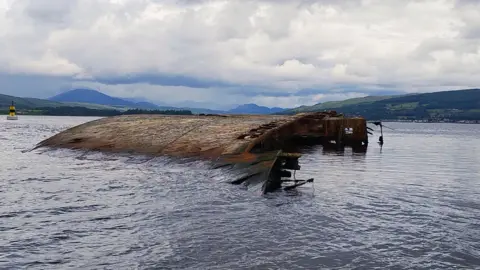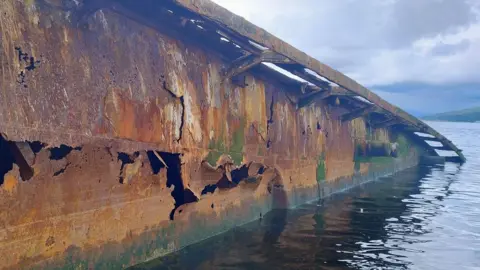'Sugar boat' shipwreck set to sink from view
 BBC
BBCIt has been a landmark in the River Clyde for more than 50 years.
But now the famous "sugar boat" shipwreck between Helensburgh and Greenock is nearing a watery grave, according to local experts.
Harsh weather throughout the winter, including Storm Éowyn, has accelerated the vessel's decline.
Jason Coles, a tour operator specialising in wrecks and dives, told BBC Scotland News that while he previously believed it would take around 30 years before the ship disappeared, he now estimates it will be gone in half that time - at most.
The MV Captayannis was struck by strong winds on 27 January 1974, when moored on the Clyde while waiting to waiting to unload raw east African sugar for the Tate & Lyle refinery in Greenock.
As the ship drifted, captain Theodorakis Ionnis hoped to reach Gare Loch and find shelter there.
However the ship drifted into the anchor chains of a BP tanker called British Light - an incident which ripped a hole in the hull of the Captayannis below the waterline.
Rescuers set out to help, and the Captayannis crew were able to escape onto the MV Rover passenger launch - but in the aftermath the ship itself keeled over, where it has remained since.

In the years since the accident the ship has become a popular tourist attraction, letting visitors see a real-life shipwreck up close, without having to dive into the depths.
It has also become a home for sea birds and fish, but when Jason Coles travelled to see the boat earlier this year, he found it eerily quiet.
"Everything had been stripped away," he explains.
"It didn't look like the sugar boat - there wasn't a bird to be seen, there wasn't even any fish guts lying on it, and a few of the layers of hull had been stripped away as well, showing signs of fracture.
"The weather was really harsh [over winter], and it looks like the waves have come over the top of the hull and landed on the wreck. It's made such an indentation, it's incredible – the weight of all that water has buckled the main decks."
The sugar boat's damage
Mr Coles estimated a crack in the bottom of the hull has quadrupled, while the majority of the hull's starboard side has collapsed inwards and buckled.
Other parts of the boat have been torn open from stormy weather.
Mr Coles suspects the added damage will make the boat more vulnerable to future bad weather, creating a cycle that will only end when the Captayannis finally sinks for good.
He believes that will be a sad sight, as the boat is a local fixture - to the extent a Helensburgh hotel and restaurant are named after it.
It is also a link to the past for the west of Scotland as a whole.
Mr Coles, who has run his company Wreckspeditions from Dunoon since 2018, said: "The Clyde and Glasgow were the biggest powerhouses in shipbuilding, and I think the sugar industry stopped only a few years after the sinking so it's almost a reminder of when that industry stopped in the Clyde.
"She's done well to last 50 years, really – everyone thinks of the Clyde as being very sheltered but we do get rough water here and some strong winds. "

While the boat was inevitably going to sink eventually, Mr Coles believes the timeline has been sped up drastically.
He said: "The difference in the past several months was quite stark. The storms and the weather are becoming more variable and more extreme.
"I used to say it'd be there for another 20 or 30 years, but after seeing that there's no chance it'll be that long. You're probably talking half of that time, at most."
Ownership of the boat has been disputed since the accident, which is partly why it was never salvaged.
Mr Coles believes nothing more can be done for the ship.
He said: "I don't think anything can be done, you can't really protect her. It's just the nature of the beast, the more she gets hit.
"I'd love it to be there forever but she will go down at some point - we just have to keep an eye on her and enjoy her while we can."
